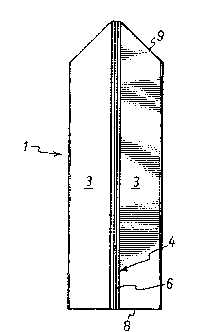Une partie des informations de ce site Web a été fournie par des sources externes. Le gouvernement du Canada n'assume aucune responsabilité concernant la précision, l'actualité ou la fiabilité des informations fournies par les sources externes. Les utilisateurs qui désirent employer cette information devraient consulter directement la source des informations. Le contenu fourni par les sources externes n'est pas assujetti aux exigences sur les langues officielles, la protection des renseignements personnels et l'accessibilité.
L'apparition de différences dans le texte et l'image des Revendications et de l'Abrégé dépend du moment auquel le document est publié. Les textes des Revendications et de l'Abrégé sont affichés :
| (12) Brevet: | (11) CA 1306941 |
|---|---|
| (21) Numéro de la demande: | 1306941 |
| (54) Titre français: | GUIDE DE COUPE |
| (54) Titre anglais: | CUTTING GUIDE |
| Statut: | Périmé et au-delà du délai pour l’annulation |
| (51) Classification internationale des brevets (CIB): |
|
|---|---|
| (72) Inventeurs : |
|
| (73) Titulaires : |
|
| (71) Demandeurs : |
|
| (74) Agent: | ROBIC AGENCE PI S.E.C./ROBIC IP AGENCY LP |
| (74) Co-agent: | |
| (45) Délivré: | 1992-09-01 |
| (22) Date de dépôt: | 1988-10-03 |
| Licence disponible: | S.O. |
| Cédé au domaine public: | S.O. |
| (25) Langue des documents déposés: | Anglais |
| Traité de coopération en matière de brevets (PCT): | Non |
|---|
| (30) Données de priorité de la demande: | ||||||
|---|---|---|---|---|---|---|
|
ABSTRACT OF THE DISCLOSURE:
A cutting guide for use in making a cut in a carpet
comprises an elongate base having a flat bottom surface and
two upper ramp surfaces separated at the apex by two
channels which extend along the base. The guide walls of
the channels are at opposite oblique angle relative to the
upper ramp surfaces so that when the guide is placed
underneath a carpet and a knife drawn along the channel in
contact with a guide wall, the cut edge thereby produced in
the carpet is at an oblique angle to the plane of the
carpet. When two such edges of different portions of carpet
are abutted together, a tidy unobtrusive seam is produced.
Note : Les revendications sont présentées dans la langue officielle dans laquelle elles ont été soumises.
Note : Les descriptions sont présentées dans la langue officielle dans laquelle elles ont été soumises.

2024-08-01 : Dans le cadre de la transition vers les Brevets de nouvelle génération (BNG), la base de données sur les brevets canadiens (BDBC) contient désormais un Historique d'événement plus détaillé, qui reproduit le Journal des événements de notre nouvelle solution interne.
Veuillez noter que les événements débutant par « Inactive : » se réfèrent à des événements qui ne sont plus utilisés dans notre nouvelle solution interne.
Pour une meilleure compréhension de l'état de la demande ou brevet qui figure sur cette page, la rubrique Mise en garde , et les descriptions de Brevet , Historique d'événement , Taxes périodiques et Historique des paiements devraient être consultées.
| Description | Date |
|---|---|
| Inactive : CIB de MCD | 2006-03-11 |
| Inactive : CIB de MCD | 2006-03-11 |
| Inactive : CIB de MCD | 2006-03-11 |
| Le délai pour l'annulation est expiré | 2004-09-01 |
| Lettre envoyée | 2003-09-02 |
| Accordé par délivrance | 1992-09-01 |
Il n'y a pas d'historique d'abandonnement
| Type de taxes | Anniversaire | Échéance | Date payée |
|---|---|---|---|
| TM (catégorie 1, 5e anniv.) - générale | 1997-09-02 | 1997-08-29 | |
| TM (catégorie 1, 6e anniv.) - générale | 1998-09-01 | 1998-08-19 | |
| TM (catégorie 1, 7e anniv.) - générale | 1999-09-01 | 1999-08-18 | |
| TM (catégorie 1, 8e anniv.) - générale | 2000-09-01 | 2000-08-16 | |
| TM (catégorie 1, 9e anniv.) - générale | 2001-09-03 | 2001-08-17 | |
| TM (catégorie 1, 10e anniv.) - générale | 2002-09-03 | 2002-08-16 |
Les titulaires actuels et antérieures au dossier sont affichés en ordre alphabétique.
| Titulaires actuels au dossier |
|---|
| DURALAY LIMITED |
| Titulaires antérieures au dossier |
|---|
| JONATHAN WARD |